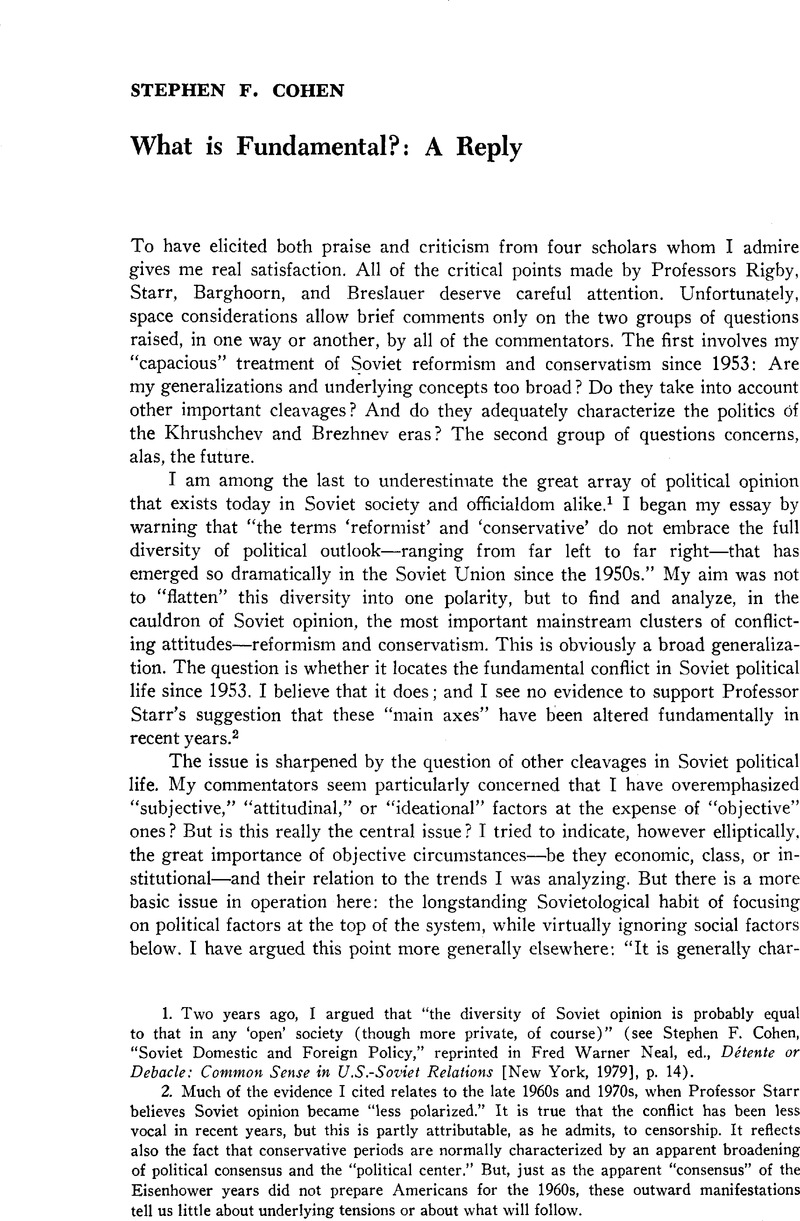No CrossRef data available.
Article contents
What is Fundamental?: A Reply
Published online by Cambridge University Press: 27 January 2017
Abstract

- Type
- Discussion
- Information
- Copyright
- Copyright © Association for Slavic, East European, and Eurasian Studies. 1979
References
1. Two years ago, I argued that “the diversity of Soviet opinion is probably equal to that in any ‘open’ society (though more private, of course)” (see Cohen, Stephen F., “Soviet Domestic and Foreign Policy,” reprinted in Neal, Fred Warner, ed., Détente or Debacle: Common Sense in U.S.-Soviet Relations [New York, 1979], p. 14).Google Scholar
2. Much of the evidence I cited relates to the late 1960s and 1970s, when Professor Starr believes Soviet opinion became “less polarized.” It is true that the conflict has been less vocal in recent years, but this is partly attributable, as he admits, to censorship. It reflects also the fact that conservative periods are normally characterized by an apparent broadening of political consensus and the “political center.” But, just as the apparent “consensus” of the Eisenhower years did not prepare Americans for the 1960s, these outward manifestations tell us little about underlying tensions or about what will follow.
3. See Cohen, Stephen F., “Bolshevism and Stalinism,” in Tucker, Robert C., ed., Stalinism: Essays in Historical Interpretation (New York, 1977), p. 7.Google Scholar
4. This point has also been argued by Hough, Jerry F., The Soviet Union and Social Science Theory (Cambridge, Mass., 1977), p. 3.CrossRefGoogle Scholar
5. Skilling, in Skilling, H. Gordon and Griffiths, Franklyn, eds., Interest Groups in Soviet Politics (Princeton, 1971), p. 395.Google Scholar The same point is made by Juviler, in Juviler, Peter H. and Morton, Henry W., eds., Soviet Policy-Making: Studies of Communism in Transition (New York, 1967), p. 54.Google Scholar
6. See Robert, Sharlet, , “Legal Policy Under Khrushchev and Brezhnev: Continuity and Change,” in Barry, Donald D., Ginsburgs, George, and Maggs, Peter B., eds., Soviet Law After Stalin, part 2: Social Engineering Through Law (Alphen aan den Rijn, The Netherlands, 1978), pp. 324–25.Google Scholar
7. As I pointed out in my essay (p. 201, note 52), the interaction between Soviet and East European reformers is an important part of the story; and attacks by Soviet conservatives on East European reformers are often aimed as well at similar proposals at home (see, for example, Georgiev, Yu, “Yugoslavia: ‘New Variant of Socialism, ’” Current Digest of the Soviet Press, 20, no. 52 (January 15, 1969): 3–8, 24.Google Scholar
8. See Rogin, Michael Paul, The Intellectuals and McCarthy: The Radical Specter (Cambridge, Mass., 1969), chapter 2Google Scholar.
9. See, for example, the political novels of the conservative writer and former high official, Vsevolod Kochetov, and especially his Chego she ty khochesh’ ?.
10. In thinking about the comparative dimensions of their problem, Soviet reformers themselves look foremost, of course, to the Communist countries of Eastern Europe. But they have also written, though more Aesopianly, on contemporary reformist efforts in non- Communist settings (see, for example, Mchedlov, M. P., Evoliutsiia sovremennogo katolitsisma [Moscow, 1966]Google Scholar; and Fedor, Burlatskii, Ispaniia: Korrida i kaudil'o [Moscow, 1967]Google Scholar, to which Aron Katsenelinboigen drew my attention).
11. Raeff, Marc, “The Bureaucratic Phenomena of Imperial Russia, 1700-1905,” American Historical Review, 84, no. 2 (April 1979): 408.CrossRefGoogle Scholar


